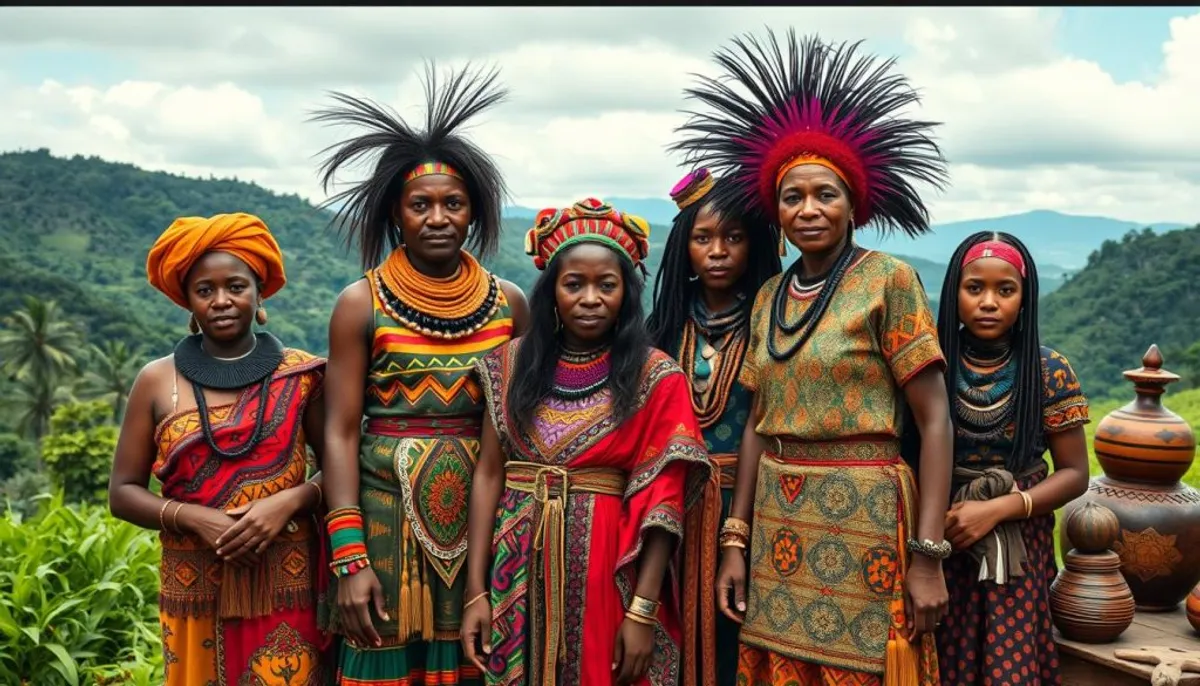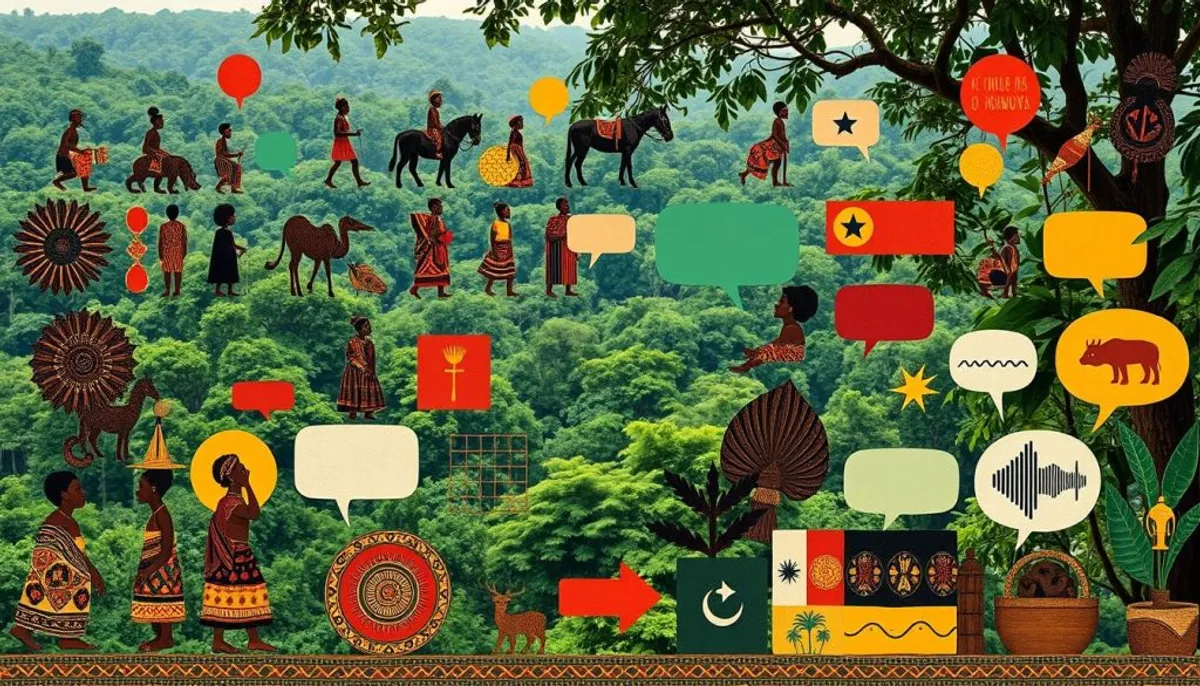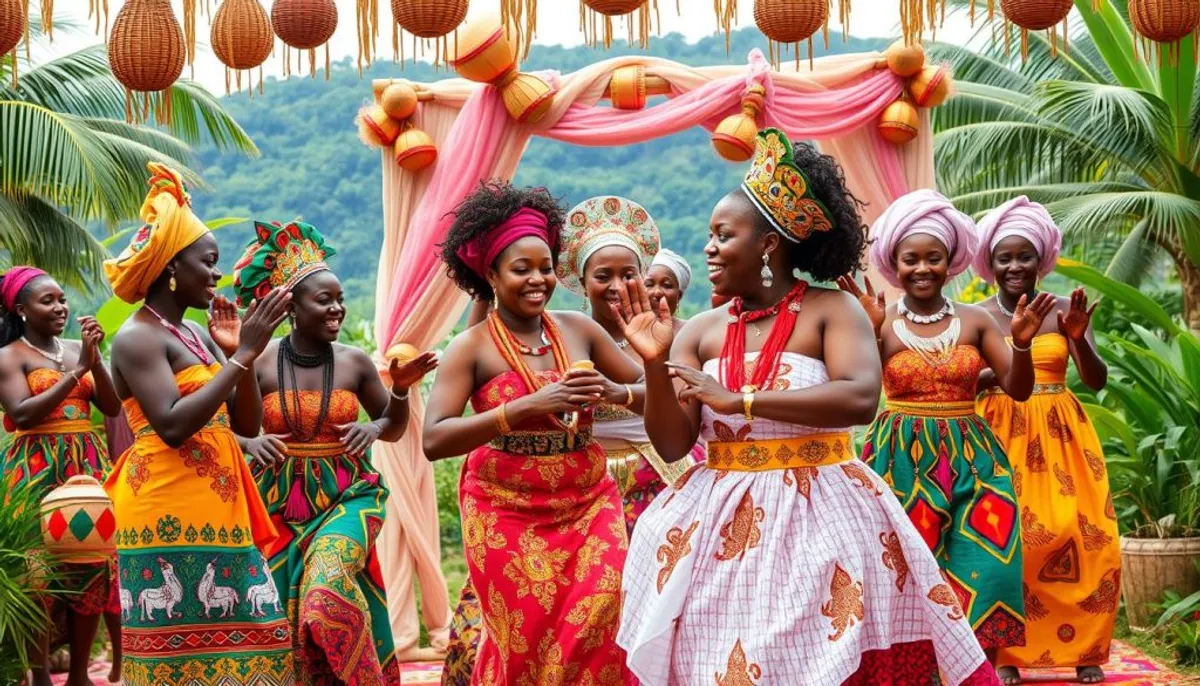The Congolese culture presents itself as a true mosaic of traditions and customs. With a population of 105 million inhabitants, the Democratic Republic of the Congo is a true treasure of ethnic diversity. This country, located in the heart of Central Africa, has more than 450 languages and just as many ethnic groups. Each contributes to the extraordinary cultural heritage of the Congo.

The geographical diversity of the Congo, ranging from dense forests to vast savannas, has influenced various traditional lifestyles. Despite the impacts of colonial influences and recent conflicts, ancestral customs continue to thrive. This resilience demonstrates the deep attachment of Congolese people to their roots.
The Congolese culture permeates all aspects of daily life. From wedding ceremonies to the captivating rhythms of rumba, along with a rich and varied cuisine, each element tells a story. These traditions serve as a link between communities, passing values from one generation to the next.
What is Congolese culture: an overview of peoples and languages
The Congolese culture is distinguished by a great variety of ethnic groups and languages. With a population of 109,717,326 inhabitants in 2024, the Congo is a true mosaic of traditions and customs. This diversity is both fascinating and complex.
The four major ethnic families of the Congo
The Congolese ethnic groups are divided into four main families:
- The Bantu: the majority, they represent the largest part of the population
- The Pygmies: about 30,000 people, living mainly in the forests of the north and west
- The East Africans: an influential minority
- The Hamites: a smaller but culturally distinct group
Non-Bantu tribes make up only 3% of the total population of the Congo.
The linguistic diversity: French and national languages
The Congolese linguistic landscape is rich and varied. French in the DRC is the official language, used in administration and education. Three Congolese languages of Bantu origin have the status of national languages:
- Lingala
- Tshiluba
- Kikongo ya leta

The role of communities in Congolese society
Communities play a crucial role in social life and cultural identity in the Congo. In urban areas, mixed marriages between different ethnic groups are common, fostering cultural exchange. Nganda, local restaurants, are important places for socialization where discussions and culinary sharing reflect the richness of Congolese cuisine.
The worship of ancestors and traditional spirituality
African spirituality finds its origin in the worship of ancestors. This practice, essential in traditional societies, shapes daily life in the Congo. It coexists with modern religions, creating a rich and diverse spiritual landscape. The cultural identity of the Congo is deeply influenced by these beliefs and practices, which are passed down from generation to generation.
The importance of masks and rituals
Congolese masks are at the heart of traditional spirituality. They serve as a link between the world of the living and that of the spirits. During ceremonies, they come alive, embodying ancestors or supernatural entities.
Rituals, varied according to regions and ethnicities, aim to honor ancestors or seek protection and prosperity. These practices maintain traditions and strengthen community bonds.
Ceremonies and offerings to ancestors
The worship of ancestors is manifested through regular ceremonies. Families offer foods, drinks, or precious objects. These symbolic acts aim to maintain a harmonious relationship with the deceased, seen as spiritual guides.
| Type of offering | Meaning | Frequency |
|---|---|---|
| Food | Feeding the spirit of the ancestor | Daily |
| Libations | Honoring and communicating | Weekly |
| Precious objects | Seeking favors or protection | Occasional |
The role of spirits in daily life
In African spirituality, spirits play an omnipresent role. They influence harvests, health, and social relationships. Congolese people consult traditional healers or mediums to communicate with these invisible entities. This belief in the constant intervention of spirits shapes their worldview and daily decisions.
Marriage and family traditions

Congolese marriage is an event rich in family traditions. The bride price remains a central practice, symbolizing the union between two families. Among the Bashi, a people from the East of the DRC, the bride price called “ngulo” is negotiated according to strict protocols. It may include cows, money, goats, and various symbolic objects.
The Congolese family places great importance on procreation, considered a wealth. Marriage is seen as a means to create alliances between clans or tribes. Some ethnic groups, like the Yansi of Kwilu, have particular marriage practices. The “Kintuidi,” although declining, allowed unions within the maternal lineage.
While polygamy remains present in some regions, practices are evolving with urbanization. The phenomenon of the “second office” (extramarital relationship) persists in large cities. Wedding ceremonies often blend traditional rites with modern celebrations, reflecting the evolution of Congolese family traditions.
- The bride price remains central to Congolese marriage
- Procreation is seen as a family wealth
- Marriage practices vary according to ethnicities
- Traditions evolve with urbanization
Arts and cultural expressions
Congolese art unfolds through a variety of cultural forms. Music and dance play an essential role in the lives of Congolese people. Craftsmanship and visual arts reflect creativity and ancestral know-how.
Congolese music and rumba
Congolese rumba is an iconic musical genre of the Congo. Emerging in the 1940s, it gained popularity across the African continent and beyond. Figures like Papa Wemba and Koffi Olomidé have enhanced its international fame. This music fuses traditional rhythms with Cuban influences, offering a unique and captivating sound. The African cultural diversity is also reflected in this music, which celebrates the different traditions and stories of the continent.
Traditional dances and their meanings
Congolese dance is a pillar of culture. Each region has its own dances, performed during ceremonies and festivals. These dances tell stories, celebrate important events, or honor ancestors. Dancers, dressed in colorful costumes and masks, add a spectacular visual dimension to their performances. In this artistic expression, film criticism, or cinema critique, plays an essential role in analyzing the representation of these dances in films and documentaries.
Crafts and visual arts
Congolese sculpture is renowned for its finesse and expressiveness. Masks, statues, and ritual objects reflect spirituality and traditional beliefs. Contemporary painting often draws inspiration from ancestral motifs. The wax cloth, a fabric with colorful patterns, is an important cultural element. It serves as clothing but also as a means of communication, its patterns conveying subtle messages.
Cuisine and culinary traditions
Congolese cuisine, a true mosaic of flavors, reflects the richness of its 450 ethnic groups. It draws inspiration from local resources and foreign influences, such as Belgian, French, Portuguese, and Arab. Cassava, an essential ingredient, is transformed into fufu and chikwanga, key elements of Congolese traditional dishes.
Staple foods and traditional dishes
Fufu, a dough made from cassava or corn, dominates Congolese tables. Chikwanga, a fermented cassava bread, is also highly valued. Congolese people enjoy a variety of meats, fish, and vegetables. Among the favorite dishes are chicken moambé, saka-saka, and madesu. Kinshasa cuisine is distinguished by its diversity, often offering several side dishes and vegetables at once. The preparation methods of these dishes reflect the unique culinary traditions of the country.
Ancestral preparation methods
Culinary techniques in the Congo are passed down from generation to generation. Liboke, a steaming method using banana leaves, preserves the flavors of the ingredients. Grilled dishes, such as soso ya ko tumba (grilled chicken), are also highly appreciated. The preparation of fufu, an art that requires strength and technique, is a true challenge.
The social role of meals
In Congolese culture, meals are more than just a nutritional necessity. They symbolize a moment of sharing and conviviality, bringing together family and friends. Traditional drinks, such as tangawisi (ginger juice) or lotoko (local whisky), accompany these moments of conviviality. The fast-food chain DFC, offering African dishes, illustrates the evolution of Congolese cuisine while respecting its roots.
RelatedRelated articles


